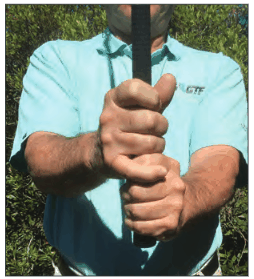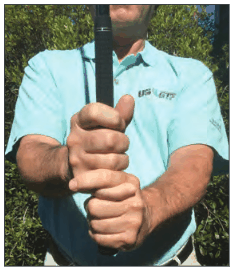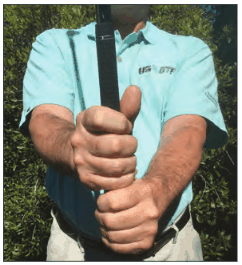Before we go any further, let’s acknowledge the obvious: You’re probably wondering why an article on the grip is appearing in Golf Teaching Pro. After all, it’s the first thing taught at USGTF certification schools, and besides, all golf teaching pros should know how to teach the grip.



Actually, you may be surprised to learn that a number of golf teaching professionals (mainly non-USGTF members) do not know how to properly teach the grip, nor do they have a firm understanding of the cause and effect associated with the three grips. Our USGTF examining staff has found more than one teaching professional who has been teaching without certification or who belongs to another organization who doesn’t know as much as they should about teaching the grip. So if you’re comfortable in your knowledge and abilities in teaching the grip and knowing its nuances, please consider this article as a refresher or confirmation. But even then, hopefully there is a nugget or two which you may take away.

Overlapping grip
This is the most commonly used and taught grip by playing and teaching professionals. This likely came about due to the influence of Harry Vardon, who popularized the grip as a way of taking some of the right-hand action out of the swing and therefore lessen the possibility of a hook. Because traditions and long-held schools of thought die hard in golf, it’s likely most teaching pros simply passed along the overlap grip as the preferred grip due to tradition. But is it really the “best” grip?
The best grip is the one which allows the golfer to return the club square the most consistently. It’s been said that every good golfer has fought a hook some-time in his or her career, so the anti-hooking features of the overlapping (or Vardon) grip are very useful to the majority of such golfers. In fact, Jim Furyk uses a double-overlap grip because of his propensity to use a lot of hand action through impact, which further promotes a hook. But that brings us to an obvious question: If the overlapping grip is an anti-hooking grip, why should we teach slicers this grip?
Hopefully our instruction will result in slicers no longer being slicers, and due to the relatively small grip a golf club possesses (in relation to others sports like baseball and tennis), it’s easy for excessive hand action to become an issue for more competent players. Thus, the overlapping grip is a good choice for these players. It also seems to allow the player to more easily put the club in the correct position in the trail hand as compared to the other grips, al-though obviously this doesn’t necessarily hold true for everyone.

Interlocking grip
The most famous practitioners of the interlocking grip include Jack Nicklaus, Tiger Woods and Rory McIlroy. Nicklaus touted the grip as being more appropriate for golfers with shorter fingers, but a number of players who don’t have shorter fingers also use the grip…and a number of players with shorter fingers also use the overlapping, so this rule of thumb doesn’t seem to be very hard and fast. (Remember, traditional thought in golf instruction tends to stick around, regardless of whether it’s accurate or not.)
Dr. Ralph Mann, a biomechanics expert who has researched golf technique to a greater degree than most, believes the interlocking grip is problematic because it allows the golfer to grip the club too much in the right palm(for right-handed players) if the golfer is not careful to avoid this.
The practical differences between the overlapping and the interlocking grip are negligible, to the point that one or the other is fine for players who choose not to use a 10-finger grip.

10-finger grip
This also known as the “baseball” grip due to its similarity to holding a bat, with no overlapping of the fingers. Major champions such as Art Wall and Bob Rosburg used the grip on their way to victory, so it has stood the test at the highest level of the game. Moe Norman, renowned for being the greatest ball striker ever, switched to the grip later in his career.
Earlier, we asked the question of why we would want our students who slice to use an anti-hook grip such as the overlap. It’s a good question, and if we have students whose tendency is to hit slices, the10-finger grip may be the best option to eliminate or mitigate the problem. Even a slight separation of the hands may be necessary to reduce slicing in some students.
Some teachers like to advocate that junior players use the 10-finger grip, with the goal of switching to the overlap or interlock later. This is feasible, as kids usually adapt swing and setup changes fairly easily as compared to adults. People with weaker hands and forearms may also benefit from the 10-finger grip. Finally, golfers who use larger arthritic grips may experience that the overlap or interlock is difficult to incorporate with such grips, finding that the 10-fingergrip offers a greater ease of use.
The USGTF Technical Committee’s official position on which grip to use is that it is up to the player and their judgment of comfort and playability. The committee has found, through its own teaching experience, that the interlocking grip seems to be a more natural grip for most people to use as compared to the overlapping, but this may be due to the factor that Dr. Mann described, which is it allows the player to hold the dominant hand grip more in the palm. This feeling is undoubtedly more secure for many players, but it represents a false security as it restricts the proper movement of the club throughout the swing.
Golf teaching professionals usually have little reason to change the type of grip their students are using, but in some cases a change may be for the better. Knowing the pros and cons of each grip can help the teacher make the correct call.
Copyright © 2023 United States Golf Teachers Federation, All Rights Reserved
200 S. Indian River Drive, Suite #206, Fort Pierce, FL 34950
772-88-USGTF or 772-595-6490 - www.usgtf.com
200 S. Indian River Drive, Suite #206, Fort Pierce, FL 34950
772-88-USGTF or 772-595-6490 - www.usgtf.com
